| LESVOS
WHAT TO SEE AROUND THE ISLAND
|
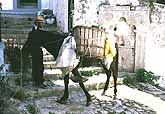
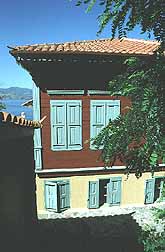
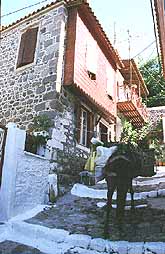
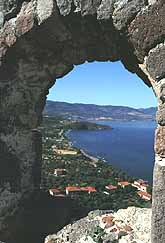
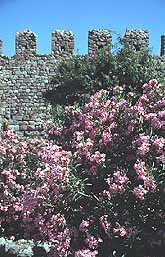
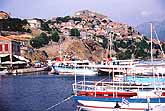
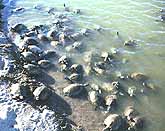
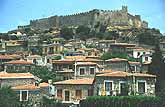
|
|
WHAT TO SEE
A.The only ruins in Greece of Aeolic style and the ruins of a Byzantine castle.
B. The ruins of Aphrodite's sanctuary.
C.The ruins of ancient Pyrrha which was destroyed by earthquake in the year 231 BC. In the bay one can see the ruins under water.The name of the bay was Pyrrhaeon Evrippos.
D. THE Kremasti Bridge , a medieval building with a tradition analogous to that of Arta Bridge.
E. THE old christian church of St George in Vassiliki style, built in the 6th century AD.
F. THE popular collection in the cultural centre .
AYIASOS
A religious centre and a centre in the art of
woodcarvings, built at the foot of mount Olympos, 28 kilometers west of
Mytilini. There are 3500 inhabitants spread in four
neighbourhoods. The village was built on this site after
a miracle happened here by Holy Mary whose icon had been
brought here by a monk called Agathon , who also built
the monastery of Panaghia of Sidon in 1170. It is claimed that the icon of
Panaghia was painted by St Luke the
Evangelist.
WHAT TO SEE
A.THE monastery and church of Panaghia with the famous
icon.
B.THE Ecclesiastical Museum with old scriptures
written by hand, exquisite
icons, and wood from the Holy Cross.
C. MANY CHURCHES
D. THE Anagnostirio, a library and a collection of
objects of popular art.
ANTISSA
THE town is now inland, 76 kilometers from Mytilini.
Ancient Antissa, the birthplace of Terpandros, the poet, was by the seaside. It
was built by Aeolis. According to the legend it is here
that the waves brought the head and lyra of Orpheus
after his murder by the Maenades. Here there is a place
called Orphikia, called after Orpheus. The ancient city was destroyed by the Romans in 168
BC.
WHAT TO SEE
A.THE monastery of Ypsilou with an excellent collection
of scriptures, ecclesiastical objects and documents and the robes of
patriarch Gregorios V.
B. A collection of items and objects of a rural house.
C. MANY churches with beautiful wall paintings.
ERESSOS
THIS is the same old city that was the birthplace of
the poetress Sappho and the philosophers Theophrastos and Fanias. Its beauty
is striking. Legend has it that the god Hermes was visiting it and was supplied with the bread for the Gods from here.
WHAT TO SEE
A.THE ANCIENT CITY. According to the evidence of the
scriptures in the ancient city there was a stadium, agora, theater and
sanctuaries of Apollo, Dionysus, Poseidon and
Athina (Minerva in Latin) where there is now the small church of
Panagiouda.
B. THE Pre-Hellenic Gate on the hill, the ruins of two
towers one Venetian and one Turkish and the Roman aquarium.
C.THE Vassiliki of Afenteli and the monastery of
Pithariou.
D. THE ARCHAEOLOGICAL MUSEUM with archaic,
Hellenistic and early Christian finds.
THERMI
A traditional village with narrow stone-bedded streets
and picturesque towers amongst olive-trees and vineyards.THERMI has been
famous since antiquity for the thermal springs devoted
to the goddess Artemis.
WHAT TO SEE
A. THE small church of Panaghia Phaneromeni with
paintings by Theophilos.
B. THE Byzantine church of
Panaghia Troulotis of the 8th century AD.
C. THREE TOWERS
D. THE RUINS of pre-historic Thermi where five
different stages since about 3000 b.c. can be identified.The finds are in Mytilini
Archaeological Museum. Thermi is chronologically of the
same era and style as Poliochni in Limnos and Troy on
the opposite side of Asia Minor, although according to
finds Poliochni is the oldest. The same civilisation
is found here, although there are no palaces to show the
pre-eminence of some people and it seems that the
community was ruled on democratic principles.There is
many speculation as to how and from where this
civilisation came that appeared almost simultaneously in
Poliochni, Thermi, Troy, Samothrace, and Thrace. If we follow Mythology, which is the best
bet, Dardanos, son of Zeus, was born in Samothrace, went to
the opposite side of Asia Minor ,and his descendants
built Troy.
KALLONI
A big village with 1600 people and with a port, Scala
Kallonis, with beautiful sandy beaches, mainly a fishing port famous
for the sardines. Kalloni has been known by this name since 1300 BC.
WHAT TO SEE
A. BYZANTINE monasteries with wall paintings, icons and
ecclesiastical objects.
B. ANCIENT tombs
C. THE ruins of the ancient city.
MANTAMADOS
A traditional village of 1400 people and thereligious centre of Lesvos's
patron Taxiarchis. It is an inland village about 7 kilometers from the bay of Makriyialos, a beautiful bay embracing the small islands of Tsakmaki, Panayia, Barbalias, Aspronisos, Tsoukalas, Prasologos.
WHAT TO SEE
A. THE monastery of Taxiarchae with the old painting of
the Saint. Tradition has it that this painting is made from the mud that was created from
the blood of the monks murdered by the Saracens and the
soil. In the monastery the bag of Gregorius V is kept.
B. BYZANTINE churches
C. RUINS of Byzantine and Venetian castles.
MYTHIMNA OR MOLYVOS
A city-museum with a history of thousands of years, the
motherland of musician Arion, of the poet Eftaliotis, the city where
Venezis lived, it looks like a queen with the castle
crowning her. Built with local stones the main features are mansions
of the 18th century, narrow stoned-bedded streets, and a well
preserved, clean village which shows to the visitor the care with which
the inhabitants look after the place.
The city took its name from the daughter of the early
settler Makareas. During the Trojan War the city was a Trojan
ally and the hero Achilles attacked and conquered it
with the assistance of princess Pisidiki who was in love
with him.
WHAT TO SEE
1. The Byzantine castle which was repaired by the
Genoan Gatelouzo.
2. THE ruins of the ancient Mythimna of the 8th century BC.
3. THE public fountains built during Turkish occupation.
4. THE public baths of the last century.
5.THE archaeological collection.
6.THE churches of Taxiarchis 1795, Ayia Kyriaki and Ayios Panteleimon 1840.
PETRA
A seaside village now a tourist resort, with sandy
beaches which according to the legend was the place where Achilles anchored
his fleet during the Trojan War. There are two small islands in the bay of Petra, Ayios Georghios and Psira.
WHAT TO SEE
A. THE church of Panaghia Glykofilousa built in 1747,
27 meters high on the rock with 114 steps. Inside the church there are valuable woodcarvings, icons and other ecclesiastical items.
B. THE small church of Ayios Nikolaos of the 16th
century.
C.THE collection of Byzantine icons.
PLOMARI
This is a big town built in 1842 and now an important commercial and tourist center.
WHAT TO SEE
A. THE hidden Panaghia which is built in a rock and is
only accessible by boat. There are springs of hot water in the sea.
B. CHURCHES of the last century.
SIGGRI
Built in a volcanic landscape, it gives the visitor the
sensation of isolation, with clean waters, plenty of fish, and unique
scenery. At the entrance of the bay of Siggri there is a
small island Nissiopi with a lighthouse and fossiled
trees.
WHAT TO SEE
A. THE PETRIFIED FOSSILED FOREST. It is situated 6 kilometers from
Siggri and it is a museum of nature and one of the rarest monuments of the
world. The forest was developed in a subtropical climate
when one million years ago due to volcanic axplosion
the forest was covered with lava and the trees became
like granite. The sight is breathtaking.
B. THE Turkish castle is well preserved.
C. BYZANTINE ruins in Palaeokastro.
D. THE small island of Nisiopi with sandy beach and which one can visit by boat.
By Lelia Mitsides
Copyright: Hellenic Electronic Center
Back
to the Northeast Islands
WHAT TO SEE
A.THE monastery and church of Panaghia with the famous icon.
B.THE Ecclesiastical Museum with old scriptures written by hand, exquisite icons, and wood from the Holy Cross.
C. MANY CHURCHES
D. THE Anagnostirio, a library and a collection of
objects of popular art.
ANTISSA
THE town is now inland, 76 kilometers from Mytilini.
Ancient Antissa, the birthplace of Terpandros, the poet, was by the seaside. It
was built by Aeolis. According to the legend it is here
that the waves brought the head and lyra of Orpheus
after his murder by the Maenades. Here there is a place
called Orphikia, called after Orpheus. The ancient city was destroyed by the Romans in 168
BC.
WHAT TO SEE
A.THE monastery of Ypsilou with an excellent collection
of scriptures, ecclesiastical objects and documents and the robes of
patriarch Gregorios V.
B. A collection of items and objects of a rural house.
C. MANY churches with beautiful wall paintings.
ERESSOS
THIS is the same old city that was the birthplace of
the poetress Sappho and the philosophers Theophrastos and Fanias. Its beauty
is striking. Legend has it that the god Hermes was visiting it and was supplied with the bread for the Gods from here.
WHAT TO SEE
A.THE ANCIENT CITY. According to the evidence of the
scriptures in the ancient city there was a stadium, agora, theater and
sanctuaries of Apollo, Dionysus, Poseidon and
Athina (Minerva in Latin) where there is now the small church of
Panagiouda.
B. THE Pre-Hellenic Gate on the hill, the ruins of two
towers one Venetian and one Turkish and the Roman aquarium.
C.THE Vassiliki of Afenteli and the monastery of
Pithariou.
D. THE ARCHAEOLOGICAL MUSEUM with archaic,
Hellenistic and early Christian finds.
THERMI
A traditional village with narrow stone-bedded streets
and picturesque towers amongst olive-trees and vineyards.THERMI has been
famous since antiquity for the thermal springs devoted
to the goddess Artemis.
WHAT TO SEE
A. THE small church of Panaghia Phaneromeni with
paintings by Theophilos.
B. THE Byzantine church of
Panaghia Troulotis of the 8th century AD.
C. THREE TOWERS
D. THE RUINS of pre-historic Thermi where five
different stages since about 3000 b.c. can be identified.The finds are in Mytilini
Archaeological Museum. Thermi is chronologically of the
same era and style as Poliochni in Limnos and Troy on
the opposite side of Asia Minor, although according to
finds Poliochni is the oldest. The same civilisation
is found here, although there are no palaces to show the
pre-eminence of some people and it seems that the
community was ruled on democratic principles.There is
many speculation as to how and from where this
civilisation came that appeared almost simultaneously in
Poliochni, Thermi, Troy, Samothrace, and Thrace. If we follow Mythology, which is the best
bet, Dardanos, son of Zeus, was born in Samothrace, went to
the opposite side of Asia Minor ,and his descendants
built Troy.
KALLONI
A big village with 1600 people and with a port, Scala
Kallonis, with beautiful sandy beaches, mainly a fishing port famous
for the sardines. Kalloni has been known by this name since 1300 BC.
WHAT TO SEE
A. BYZANTINE monasteries with wall paintings, icons and
ecclesiastical objects.
B. ANCIENT tombs
C. THE ruins of the ancient city.
MANTAMADOS
A traditional village of 1400 people and thereligious centre of Lesvos's
patron Taxiarchis. It is an inland village about 7 kilometers from the bay of Makriyialos, a beautiful bay embracing the small islands of Tsakmaki, Panayia, Barbalias, Aspronisos, Tsoukalas, Prasologos.
WHAT TO SEE
A. THE monastery of Taxiarchae with the old painting of
the Saint. Tradition has it that this painting is made from the mud that was created from
the blood of the monks murdered by the Saracens and the
soil. In the monastery the bag of Gregorius V is kept.
B. BYZANTINE churches
C. RUINS of Byzantine and Venetian castles.
MYTHIMNA OR MOLYVOS
A city-museum with a history of thousands of years, the
motherland of musician Arion, of the poet Eftaliotis, the city where
Venezis lived, it looks like a queen with the castle
crowning her. Built with local stones the main features are mansions
of the 18th century, narrow stoned-bedded streets, and a well
preserved, clean village which shows to the visitor the care with which
the inhabitants look after the place.
The city took its name from the daughter of the early
settler Makareas. During the Trojan War the city was a Trojan
ally and the hero Achilles attacked and conquered it
with the assistance of princess Pisidiki who was in love
with him.
WHAT TO SEE
1. The Byzantine castle which was repaired by the
Genoan Gatelouzo.
2. THE ruins of the ancient Mythimna of the 8th century BC.
3. THE public fountains built during Turkish occupation.
4. THE public baths of the last century.
5.THE archaeological collection.
6.THE churches of Taxiarchis 1795, Ayia Kyriaki and Ayios Panteleimon 1840.
PETRA
A seaside village now a tourist resort, with sandy
beaches which according to the legend was the place where Achilles anchored
his fleet during the Trojan War. There are two small islands in the bay of Petra, Ayios Georghios and Psira.
WHAT TO SEE
A. THE church of Panaghia Glykofilousa built in 1747,
27 meters high on the rock with 114 steps. Inside the church there are valuable woodcarvings, icons and other ecclesiastical items.
B. THE small church of Ayios Nikolaos of the 16th
century.
C.THE collection of Byzantine icons.
PLOMARI
This is a big town built in 1842 and now an important commercial and tourist center.
WHAT TO SEE
A. THE hidden Panaghia which is built in a rock and is
only accessible by boat. There are springs of hot water in the sea.
B. CHURCHES of the last century.
SIGGRI
Built in a volcanic landscape, it gives the visitor the
sensation of isolation, with clean waters, plenty of fish, and unique
scenery. At the entrance of the bay of Siggri there is a
small island Nissiopi with a lighthouse and fossiled
trees.
WHAT TO SEE
A. THE PETRIFIED FOSSILED FOREST. It is situated 6 kilometers from
Siggri and it is a museum of nature and one of the rarest monuments of the
world. The forest was developed in a subtropical climate
when one million years ago due to volcanic axplosion
the forest was covered with lava and the trees became
like granite. The sight is breathtaking.
B. THE Turkish castle is well preserved.
C. BYZANTINE ruins in Palaeokastro.
D. THE small island of Nisiopi with sandy beach and which one can visit by boat.
By Lelia Mitsides
Copyright: Hellenic Electronic Center
Back
to the Northeast Islands
WHAT TO SEE
A.THE monastery of Ypsilou with an excellent collection of scriptures, ecclesiastical objects and documents and the robes of patriarch Gregorios V.
B. A collection of items and objects of a rural house.
C. MANY churches with beautiful wall paintings.
ERESSOS
THIS is the same old city that was the birthplace of
the poetress Sappho and the philosophers Theophrastos and Fanias. Its beauty
is striking. Legend has it that the god Hermes was visiting it and was supplied with the bread for the Gods from here.
WHAT TO SEE
A.THE ANCIENT CITY. According to the evidence of the
scriptures in the ancient city there was a stadium, agora, theater and
sanctuaries of Apollo, Dionysus, Poseidon and
Athina (Minerva in Latin) where there is now the small church of
Panagiouda.
B. THE Pre-Hellenic Gate on the hill, the ruins of two
towers one Venetian and one Turkish and the Roman aquarium.
C.THE Vassiliki of Afenteli and the monastery of
Pithariou.
D. THE ARCHAEOLOGICAL MUSEUM with archaic,
Hellenistic and early Christian finds.
THERMI
A traditional village with narrow stone-bedded streets
and picturesque towers amongst olive-trees and vineyards.THERMI has been
famous since antiquity for the thermal springs devoted
to the goddess Artemis.
WHAT TO SEE
A. THE small church of Panaghia Phaneromeni with
paintings by Theophilos.
B. THE Byzantine church of
Panaghia Troulotis of the 8th century AD.
C. THREE TOWERS
D. THE RUINS of pre-historic Thermi where five
different stages since about 3000 b.c. can be identified.The finds are in Mytilini
Archaeological Museum. Thermi is chronologically of the
same era and style as Poliochni in Limnos and Troy on
the opposite side of Asia Minor, although according to
finds Poliochni is the oldest. The same civilisation
is found here, although there are no palaces to show the
pre-eminence of some people and it seems that the
community was ruled on democratic principles.There is
many speculation as to how and from where this
civilisation came that appeared almost simultaneously in
Poliochni, Thermi, Troy, Samothrace, and Thrace. If we follow Mythology, which is the best
bet, Dardanos, son of Zeus, was born in Samothrace, went to
the opposite side of Asia Minor ,and his descendants
built Troy.
KALLONI
A big village with 1600 people and with a port, Scala
Kallonis, with beautiful sandy beaches, mainly a fishing port famous
for the sardines. Kalloni has been known by this name since 1300 BC.
WHAT TO SEE
A. BYZANTINE monasteries with wall paintings, icons and
ecclesiastical objects.
B. ANCIENT tombs
C. THE ruins of the ancient city.
MANTAMADOS
A traditional village of 1400 people and thereligious centre of Lesvos's
patron Taxiarchis. It is an inland village about 7 kilometers from the bay of Makriyialos, a beautiful bay embracing the small islands of Tsakmaki, Panayia, Barbalias, Aspronisos, Tsoukalas, Prasologos.
WHAT TO SEE
A. THE monastery of Taxiarchae with the old painting of
the Saint. Tradition has it that this painting is made from the mud that was created from
the blood of the monks murdered by the Saracens and the
soil. In the monastery the bag of Gregorius V is kept.
B. BYZANTINE churches
C. RUINS of Byzantine and Venetian castles.
MYTHIMNA OR MOLYVOS
A city-museum with a history of thousands of years, the
motherland of musician Arion, of the poet Eftaliotis, the city where
Venezis lived, it looks like a queen with the castle
crowning her. Built with local stones the main features are mansions
of the 18th century, narrow stoned-bedded streets, and a well
preserved, clean village which shows to the visitor the care with which
the inhabitants look after the place.
The city took its name from the daughter of the early
settler Makareas. During the Trojan War the city was a Trojan
ally and the hero Achilles attacked and conquered it
with the assistance of princess Pisidiki who was in love
with him.
WHAT TO SEE
1. The Byzantine castle which was repaired by the
Genoan Gatelouzo.
2. THE ruins of the ancient Mythimna of the 8th century BC.
3. THE public fountains built during Turkish occupation.
4. THE public baths of the last century.
5.THE archaeological collection.
6.THE churches of Taxiarchis 1795, Ayia Kyriaki and Ayios Panteleimon 1840.
PETRA
A seaside village now a tourist resort, with sandy
beaches which according to the legend was the place where Achilles anchored
his fleet during the Trojan War. There are two small islands in the bay of Petra, Ayios Georghios and Psira.
WHAT TO SEE
A. THE church of Panaghia Glykofilousa built in 1747,
27 meters high on the rock with 114 steps. Inside the church there are valuable woodcarvings, icons and other ecclesiastical items.
B. THE small church of Ayios Nikolaos of the 16th
century.
C.THE collection of Byzantine icons.
PLOMARI
This is a big town built in 1842 and now an important commercial and tourist center.
WHAT TO SEE
A. THE hidden Panaghia which is built in a rock and is
only accessible by boat. There are springs of hot water in the sea.
B. CHURCHES of the last century.
SIGGRI
Built in a volcanic landscape, it gives the visitor the
sensation of isolation, with clean waters, plenty of fish, and unique
scenery. At the entrance of the bay of Siggri there is a
small island Nissiopi with a lighthouse and fossiled
trees.
WHAT TO SEE
A. THE PETRIFIED FOSSILED FOREST. It is situated 6 kilometers from
Siggri and it is a museum of nature and one of the rarest monuments of the
world. The forest was developed in a subtropical climate
when one million years ago due to volcanic axplosion
the forest was covered with lava and the trees became
like granite. The sight is breathtaking.
B. THE Turkish castle is well preserved.
C. BYZANTINE ruins in Palaeokastro.
D. THE small island of Nisiopi with sandy beach and which one can visit by boat.
By Lelia Mitsides
Copyright: Hellenic Electronic Center
Back
to the Northeast Islands
WHAT TO SEE
A.THE ANCIENT CITY. According to the evidence of the scriptures in the ancient city there was a stadium, agora, theater and sanctuaries of Apollo, Dionysus, Poseidon and Athina (Minerva in Latin) where there is now the small church of Panagiouda.
B. THE Pre-Hellenic Gate on the hill, the ruins of two towers one Venetian and one Turkish and the Roman aquarium.
C.THE Vassiliki of Afenteli and the monastery of Pithariou.
D. THE ARCHAEOLOGICAL MUSEUM with archaic, Hellenistic and early Christian finds.
THERMI
A traditional village with narrow stone-bedded streets
and picturesque towers amongst olive-trees and vineyards.THERMI has been
famous since antiquity for the thermal springs devoted
to the goddess Artemis.
WHAT TO SEE
A. THE small church of Panaghia Phaneromeni with
paintings by Theophilos.
B. THE Byzantine church of
Panaghia Troulotis of the 8th century AD.
C. THREE TOWERS
D. THE RUINS of pre-historic Thermi where five
different stages since about 3000 b.c. can be identified.The finds are in Mytilini
Archaeological Museum. Thermi is chronologically of the
same era and style as Poliochni in Limnos and Troy on
the opposite side of Asia Minor, although according to
finds Poliochni is the oldest. The same civilisation
is found here, although there are no palaces to show the
pre-eminence of some people and it seems that the
community was ruled on democratic principles.There is
many speculation as to how and from where this
civilisation came that appeared almost simultaneously in
Poliochni, Thermi, Troy, Samothrace, and Thrace. If we follow Mythology, which is the best
bet, Dardanos, son of Zeus, was born in Samothrace, went to
the opposite side of Asia Minor ,and his descendants
built Troy.
KALLONI
A big village with 1600 people and with a port, Scala
Kallonis, with beautiful sandy beaches, mainly a fishing port famous
for the sardines. Kalloni has been known by this name since 1300 BC.
WHAT TO SEE
A. BYZANTINE monasteries with wall paintings, icons and
ecclesiastical objects.
B. ANCIENT tombs
C. THE ruins of the ancient city.
MANTAMADOS
A traditional village of 1400 people and thereligious centre of Lesvos's
patron Taxiarchis. It is an inland village about 7 kilometers from the bay of Makriyialos, a beautiful bay embracing the small islands of Tsakmaki, Panayia, Barbalias, Aspronisos, Tsoukalas, Prasologos.
WHAT TO SEE
A. THE monastery of Taxiarchae with the old painting of
the Saint. Tradition has it that this painting is made from the mud that was created from
the blood of the monks murdered by the Saracens and the
soil. In the monastery the bag of Gregorius V is kept.
B. BYZANTINE churches
C. RUINS of Byzantine and Venetian castles.
MYTHIMNA OR MOLYVOS
A city-museum with a history of thousands of years, the
motherland of musician Arion, of the poet Eftaliotis, the city where
Venezis lived, it looks like a queen with the castle
crowning her. Built with local stones the main features are mansions
of the 18th century, narrow stoned-bedded streets, and a well
preserved, clean village which shows to the visitor the care with which
the inhabitants look after the place.
The city took its name from the daughter of the early
settler Makareas. During the Trojan War the city was a Trojan
ally and the hero Achilles attacked and conquered it
with the assistance of princess Pisidiki who was in love
with him.
WHAT TO SEE
1. The Byzantine castle which was repaired by the
Genoan Gatelouzo.
2. THE ruins of the ancient Mythimna of the 8th century BC.
3. THE public fountains built during Turkish occupation.
4. THE public baths of the last century.
5.THE archaeological collection.
6.THE churches of Taxiarchis 1795, Ayia Kyriaki and Ayios Panteleimon 1840.
PETRA
A seaside village now a tourist resort, with sandy
beaches which according to the legend was the place where Achilles anchored
his fleet during the Trojan War. There are two small islands in the bay of Petra, Ayios Georghios and Psira.
WHAT TO SEE
A. THE church of Panaghia Glykofilousa built in 1747,
27 meters high on the rock with 114 steps. Inside the church there are valuable woodcarvings, icons and other ecclesiastical items.
B. THE small church of Ayios Nikolaos of the 16th
century.
C.THE collection of Byzantine icons.
PLOMARI
This is a big town built in 1842 and now an important commercial and tourist center.
WHAT TO SEE
A. THE hidden Panaghia which is built in a rock and is
only accessible by boat. There are springs of hot water in the sea.
B. CHURCHES of the last century.
SIGGRI
Built in a volcanic landscape, it gives the visitor the
sensation of isolation, with clean waters, plenty of fish, and unique
scenery. At the entrance of the bay of Siggri there is a
small island Nissiopi with a lighthouse and fossiled
trees.
WHAT TO SEE
A. THE PETRIFIED FOSSILED FOREST. It is situated 6 kilometers from
Siggri and it is a museum of nature and one of the rarest monuments of the
world. The forest was developed in a subtropical climate
when one million years ago due to volcanic axplosion
the forest was covered with lava and the trees became
like granite. The sight is breathtaking.
B. THE Turkish castle is well preserved.
C. BYZANTINE ruins in Palaeokastro.
D. THE small island of Nisiopi with sandy beach and which one can visit by boat.
By Lelia Mitsides
Copyright: Hellenic Electronic Center
Back
to the Northeast Islands
WHAT TO SEE
A. THE small church of Panaghia Phaneromeni with paintings by Theophilos.
B. THE Byzantine church of Panaghia Troulotis of the 8th century AD.
C. THREE TOWERS
D. THE RUINS of pre-historic Thermi where five different stages since about 3000 b.c. can be identified.The finds are in Mytilini Archaeological Museum. Thermi is chronologically of the same era and style as Poliochni in Limnos and Troy on the opposite side of Asia Minor, although according to finds Poliochni is the oldest. The same civilisation is found here, although there are no palaces to show the pre-eminence of some people and it seems that the community was ruled on democratic principles.There is many speculation as to how and from where this civilisation came that appeared almost simultaneously in Poliochni, Thermi, Troy, Samothrace, and Thrace. If we follow Mythology, which is the best bet, Dardanos, son of Zeus, was born in Samothrace, went to the opposite side of Asia Minor ,and his descendants built Troy.
KALLONI
A big village with 1600 people and with a port, Scala
Kallonis, with beautiful sandy beaches, mainly a fishing port famous
for the sardines. Kalloni has been known by this name since 1300 BC.
WHAT TO SEE
A. BYZANTINE monasteries with wall paintings, icons and
ecclesiastical objects.
B. ANCIENT tombs
C. THE ruins of the ancient city.
MANTAMADOS
A traditional village of 1400 people and thereligious centre of Lesvos's
patron Taxiarchis. It is an inland village about 7 kilometers from the bay of Makriyialos, a beautiful bay embracing the small islands of Tsakmaki, Panayia, Barbalias, Aspronisos, Tsoukalas, Prasologos.
WHAT TO SEE
A. THE monastery of Taxiarchae with the old painting of
the Saint. Tradition has it that this painting is made from the mud that was created from
the blood of the monks murdered by the Saracens and the
soil. In the monastery the bag of Gregorius V is kept.
B. BYZANTINE churches
C. RUINS of Byzantine and Venetian castles.
MYTHIMNA OR MOLYVOS
A city-museum with a history of thousands of years, the
motherland of musician Arion, of the poet Eftaliotis, the city where
Venezis lived, it looks like a queen with the castle
crowning her. Built with local stones the main features are mansions
of the 18th century, narrow stoned-bedded streets, and a well
preserved, clean village which shows to the visitor the care with which
the inhabitants look after the place.
The city took its name from the daughter of the early
settler Makareas. During the Trojan War the city was a Trojan
ally and the hero Achilles attacked and conquered it
with the assistance of princess Pisidiki who was in love
with him.
WHAT TO SEE
1. The Byzantine castle which was repaired by the
Genoan Gatelouzo.
2. THE ruins of the ancient Mythimna of the 8th century BC.
3. THE public fountains built during Turkish occupation.
4. THE public baths of the last century.
5.THE archaeological collection.
6.THE churches of Taxiarchis 1795, Ayia Kyriaki and Ayios Panteleimon 1840.
PETRA
A seaside village now a tourist resort, with sandy
beaches which according to the legend was the place where Achilles anchored
his fleet during the Trojan War. There are two small islands in the bay of Petra, Ayios Georghios and Psira.
WHAT TO SEE
A. THE church of Panaghia Glykofilousa built in 1747,
27 meters high on the rock with 114 steps. Inside the church there are valuable woodcarvings, icons and other ecclesiastical items.
B. THE small church of Ayios Nikolaos of the 16th
century.
C.THE collection of Byzantine icons.
PLOMARI
This is a big town built in 1842 and now an important commercial and tourist center.
WHAT TO SEE
A. THE hidden Panaghia which is built in a rock and is
only accessible by boat. There are springs of hot water in the sea.
B. CHURCHES of the last century.
SIGGRI
Built in a volcanic landscape, it gives the visitor the
sensation of isolation, with clean waters, plenty of fish, and unique
scenery. At the entrance of the bay of Siggri there is a
small island Nissiopi with a lighthouse and fossiled
trees.
WHAT TO SEE
A. THE PETRIFIED FOSSILED FOREST. It is situated 6 kilometers from
Siggri and it is a museum of nature and one of the rarest monuments of the
world. The forest was developed in a subtropical climate
when one million years ago due to volcanic axplosion
the forest was covered with lava and the trees became
like granite. The sight is breathtaking.
B. THE Turkish castle is well preserved.
C. BYZANTINE ruins in Palaeokastro.
D. THE small island of Nisiopi with sandy beach and which one can visit by boat.
By Lelia Mitsides
Copyright: Hellenic Electronic Center
Back
to the Northeast Islands
WHAT TO SEE
A. BYZANTINE monasteries with wall paintings, icons and ecclesiastical objects.
B. ANCIENT tombs
C. THE ruins of the ancient city.
MANTAMADOS
A traditional village of 1400 people and thereligious centre of Lesvos's
patron Taxiarchis. It is an inland village about 7 kilometers from the bay of Makriyialos, a beautiful bay embracing the small islands of Tsakmaki, Panayia, Barbalias, Aspronisos, Tsoukalas, Prasologos.
WHAT TO SEE
A. THE monastery of Taxiarchae with the old painting of
the Saint. Tradition has it that this painting is made from the mud that was created from
the blood of the monks murdered by the Saracens and the
soil. In the monastery the bag of Gregorius V is kept.
B. BYZANTINE churches
C. RUINS of Byzantine and Venetian castles.
MYTHIMNA OR MOLYVOS
A city-museum with a history of thousands of years, the
motherland of musician Arion, of the poet Eftaliotis, the city where
Venezis lived, it looks like a queen with the castle
crowning her. Built with local stones the main features are mansions
of the 18th century, narrow stoned-bedded streets, and a well
preserved, clean village which shows to the visitor the care with which
the inhabitants look after the place.
The city took its name from the daughter of the early
settler Makareas. During the Trojan War the city was a Trojan
ally and the hero Achilles attacked and conquered it
with the assistance of princess Pisidiki who was in love
with him.
WHAT TO SEE
1. The Byzantine castle which was repaired by the
Genoan Gatelouzo.
2. THE ruins of the ancient Mythimna of the 8th century BC.
3. THE public fountains built during Turkish occupation.
4. THE public baths of the last century.
5.THE archaeological collection.
6.THE churches of Taxiarchis 1795, Ayia Kyriaki and Ayios Panteleimon 1840.
PETRA
A seaside village now a tourist resort, with sandy
beaches which according to the legend was the place where Achilles anchored
his fleet during the Trojan War. There are two small islands in the bay of Petra, Ayios Georghios and Psira.
WHAT TO SEE
A. THE church of Panaghia Glykofilousa built in 1747,
27 meters high on the rock with 114 steps. Inside the church there are valuable woodcarvings, icons and other ecclesiastical items.
B. THE small church of Ayios Nikolaos of the 16th
century.
C.THE collection of Byzantine icons.
PLOMARI
This is a big town built in 1842 and now an important commercial and tourist center.
WHAT TO SEE
A. THE hidden Panaghia which is built in a rock and is
only accessible by boat. There are springs of hot water in the sea.
B. CHURCHES of the last century.
SIGGRI
Built in a volcanic landscape, it gives the visitor the
sensation of isolation, with clean waters, plenty of fish, and unique
scenery. At the entrance of the bay of Siggri there is a
small island Nissiopi with a lighthouse and fossiled
trees.
WHAT TO SEE
A. THE PETRIFIED FOSSILED FOREST. It is situated 6 kilometers from
Siggri and it is a museum of nature and one of the rarest monuments of the
world. The forest was developed in a subtropical climate
when one million years ago due to volcanic axplosion
the forest was covered with lava and the trees became
like granite. The sight is breathtaking.
B. THE Turkish castle is well preserved.
C. BYZANTINE ruins in Palaeokastro.
D. THE small island of Nisiopi with sandy beach and which one can visit by boat.
By Lelia Mitsides
Copyright: Hellenic Electronic Center
Back
to the Northeast Islands
WHAT TO SEE
A. THE monastery of Taxiarchae with the old painting of the Saint. Tradition has it that this painting is made from the mud that was created from the blood of the monks murdered by the Saracens and the soil. In the monastery the bag of Gregorius V is kept.
B. BYZANTINE churches
C. RUINS of Byzantine and Venetian castles.
MYTHIMNA OR MOLYVOS
A city-museum with a history of thousands of years, the
motherland of musician Arion, of the poet Eftaliotis, the city where
Venezis lived, it looks like a queen with the castle
crowning her. Built with local stones the main features are mansions
of the 18th century, narrow stoned-bedded streets, and a well
preserved, clean village which shows to the visitor the care with which
the inhabitants look after the place.
The city took its name from the daughter of the early
settler Makareas. During the Trojan War the city was a Trojan
ally and the hero Achilles attacked and conquered it
with the assistance of princess Pisidiki who was in love
with him.
WHAT TO SEE
1. The Byzantine castle which was repaired by the
Genoan Gatelouzo.
2. THE ruins of the ancient Mythimna of the 8th century BC.
3. THE public fountains built during Turkish occupation.
4. THE public baths of the last century.
5.THE archaeological collection.
6.THE churches of Taxiarchis 1795, Ayia Kyriaki and Ayios Panteleimon 1840.
PETRA
A seaside village now a tourist resort, with sandy
beaches which according to the legend was the place where Achilles anchored
his fleet during the Trojan War. There are two small islands in the bay of Petra, Ayios Georghios and Psira.
WHAT TO SEE
A. THE church of Panaghia Glykofilousa built in 1747,
27 meters high on the rock with 114 steps. Inside the church there are valuable woodcarvings, icons and other ecclesiastical items.
B. THE small church of Ayios Nikolaos of the 16th
century.
C.THE collection of Byzantine icons.
PLOMARI
This is a big town built in 1842 and now an important commercial and tourist center.
WHAT TO SEE
A. THE hidden Panaghia which is built in a rock and is
only accessible by boat. There are springs of hot water in the sea.
B. CHURCHES of the last century.
SIGGRI
Built in a volcanic landscape, it gives the visitor the
sensation of isolation, with clean waters, plenty of fish, and unique
scenery. At the entrance of the bay of Siggri there is a
small island Nissiopi with a lighthouse and fossiled
trees.
WHAT TO SEE
A. THE PETRIFIED FOSSILED FOREST. It is situated 6 kilometers from
Siggri and it is a museum of nature and one of the rarest monuments of the
world. The forest was developed in a subtropical climate
when one million years ago due to volcanic axplosion
the forest was covered with lava and the trees became
like granite. The sight is breathtaking.
B. THE Turkish castle is well preserved.
C. BYZANTINE ruins in Palaeokastro.
D. THE small island of Nisiopi with sandy beach and which one can visit by boat.
By Lelia Mitsides
Copyright: Hellenic Electronic Center
Back
to the Northeast Islands
The city took its name from the daughter of the early settler Makareas. During the Trojan War the city was a Trojan ally and the hero Achilles attacked and conquered it with the assistance of princess Pisidiki who was in love with him.
WHAT TO SEE
1. The Byzantine castle which was repaired by the Genoan Gatelouzo.
2. THE ruins of the ancient Mythimna of the 8th century BC.
3. THE public fountains built during Turkish occupation.
4. THE public baths of the last century.
5.THE archaeological collection.
6.THE churches of Taxiarchis 1795, Ayia Kyriaki and Ayios Panteleimon 1840.
PETRA
A seaside village now a tourist resort, with sandy
beaches which according to the legend was the place where Achilles anchored
his fleet during the Trojan War. There are two small islands in the bay of Petra, Ayios Georghios and Psira.
WHAT TO SEE
A. THE church of Panaghia Glykofilousa built in 1747,
27 meters high on the rock with 114 steps. Inside the church there are valuable woodcarvings, icons and other ecclesiastical items.
B. THE small church of Ayios Nikolaos of the 16th
century.
C.THE collection of Byzantine icons.
PLOMARI
This is a big town built in 1842 and now an important commercial and tourist center.
WHAT TO SEE
A. THE hidden Panaghia which is built in a rock and is
only accessible by boat. There are springs of hot water in the sea.
B. CHURCHES of the last century.
SIGGRI
Built in a volcanic landscape, it gives the visitor the
sensation of isolation, with clean waters, plenty of fish, and unique
scenery. At the entrance of the bay of Siggri there is a
small island Nissiopi with a lighthouse and fossiled
trees.
WHAT TO SEE
A. THE PETRIFIED FOSSILED FOREST. It is situated 6 kilometers from
Siggri and it is a museum of nature and one of the rarest monuments of the
world. The forest was developed in a subtropical climate
when one million years ago due to volcanic axplosion
the forest was covered with lava and the trees became
like granite. The sight is breathtaking.
B. THE Turkish castle is well preserved.
C. BYZANTINE ruins in Palaeokastro.
D. THE small island of Nisiopi with sandy beach and which one can visit by boat.
By Lelia Mitsides
Copyright: Hellenic Electronic Center
Back
to the Northeast Islands
WHAT TO SEE
A. THE church of Panaghia Glykofilousa built in 1747, 27 meters high on the rock with 114 steps. Inside the church there are valuable woodcarvings, icons and other ecclesiastical items.
B. THE small church of Ayios Nikolaos of the 16th century.
C.THE collection of Byzantine icons.
PLOMARI
This is a big town built in 1842 and now an important commercial and tourist center.
WHAT TO SEE
A. THE hidden Panaghia which is built in a rock and is
only accessible by boat. There are springs of hot water in the sea.
B. CHURCHES of the last century.
SIGGRI
Built in a volcanic landscape, it gives the visitor the
sensation of isolation, with clean waters, plenty of fish, and unique
scenery. At the entrance of the bay of Siggri there is a
small island Nissiopi with a lighthouse and fossiled
trees.
WHAT TO SEE
A. THE PETRIFIED FOSSILED FOREST. It is situated 6 kilometers from
Siggri and it is a museum of nature and one of the rarest monuments of the
world. The forest was developed in a subtropical climate
when one million years ago due to volcanic axplosion
the forest was covered with lava and the trees became
like granite. The sight is breathtaking.
B. THE Turkish castle is well preserved.
C. BYZANTINE ruins in Palaeokastro.
D. THE small island of Nisiopi with sandy beach and which one can visit by boat.
By Lelia Mitsides
Copyright: Hellenic Electronic Center
Back
to the Northeast Islands
WHAT TO SEE
A. THE hidden Panaghia which is built in a rock and is only accessible by boat. There are springs of hot water in the sea.
B. CHURCHES of the last century.
SIGGRI
Built in a volcanic landscape, it gives the visitor the
sensation of isolation, with clean waters, plenty of fish, and unique
scenery. At the entrance of the bay of Siggri there is a
small island Nissiopi with a lighthouse and fossiled
trees.
WHAT TO SEE
A. THE PETRIFIED FOSSILED FOREST. It is situated 6 kilometers from
Siggri and it is a museum of nature and one of the rarest monuments of the
world. The forest was developed in a subtropical climate
when one million years ago due to volcanic axplosion
the forest was covered with lava and the trees became
like granite. The sight is breathtaking.
B. THE Turkish castle is well preserved.
C. BYZANTINE ruins in Palaeokastro.
D. THE small island of Nisiopi with sandy beach and which one can visit by boat.
By Lelia Mitsides
Copyright: Hellenic Electronic Center
Back
to the Northeast Islands
WHAT TO SEE
A. THE PETRIFIED FOSSILED FOREST. It is situated 6 kilometers from Siggri and it is a museum of nature and one of the rarest monuments of the world. The forest was developed in a subtropical climate when one million years ago due to volcanic axplosion the forest was covered with lava and the trees became like granite. The sight is breathtaking.
B. THE Turkish castle is well preserved.
C. BYZANTINE ruins in Palaeokastro.
D. THE small island of Nisiopi with sandy beach and which one can visit by boat.
By Lelia Mitsides
Copyright: Hellenic Electronic Center
Back
to the Northeast Islands
Copyright: Hellenic Electronic Center
Back to the Northeast Islands